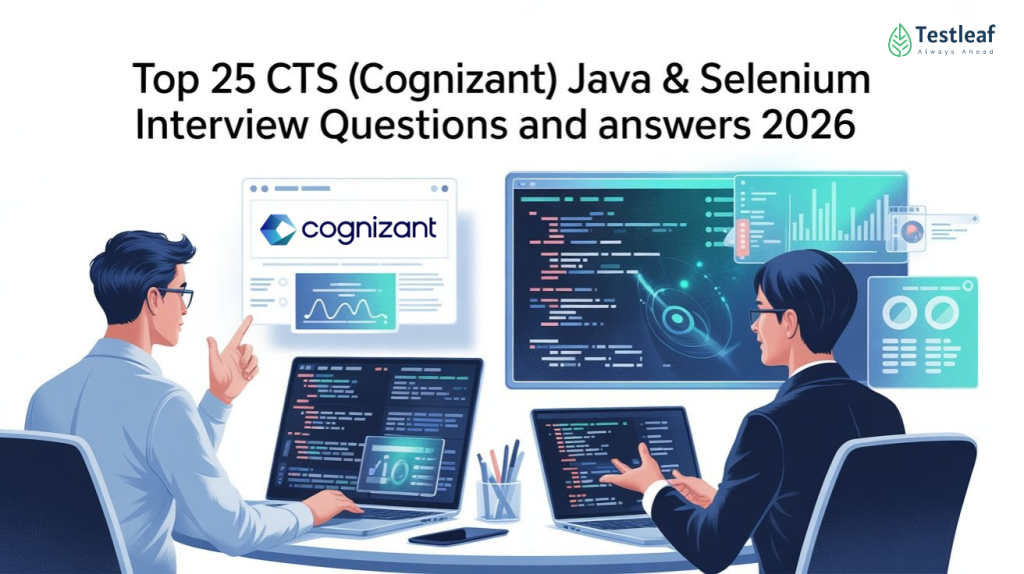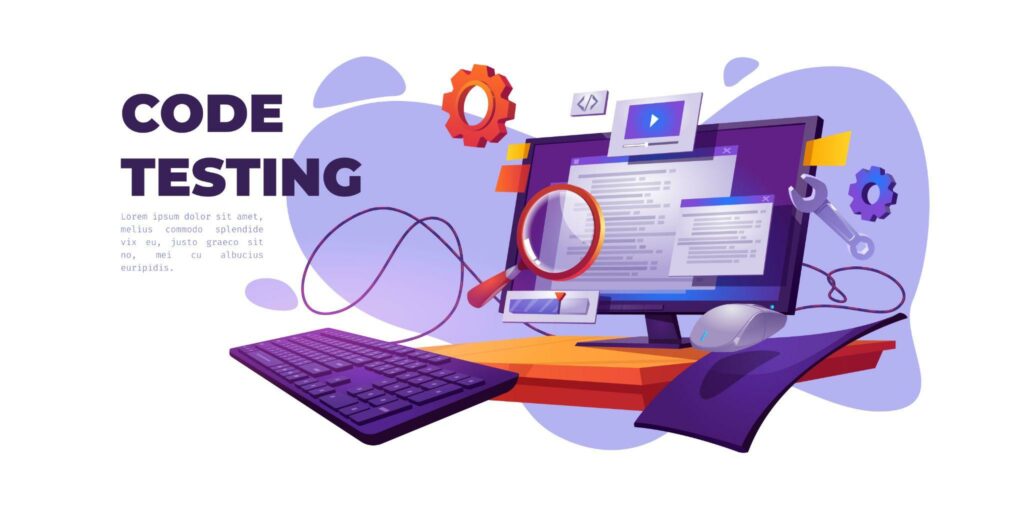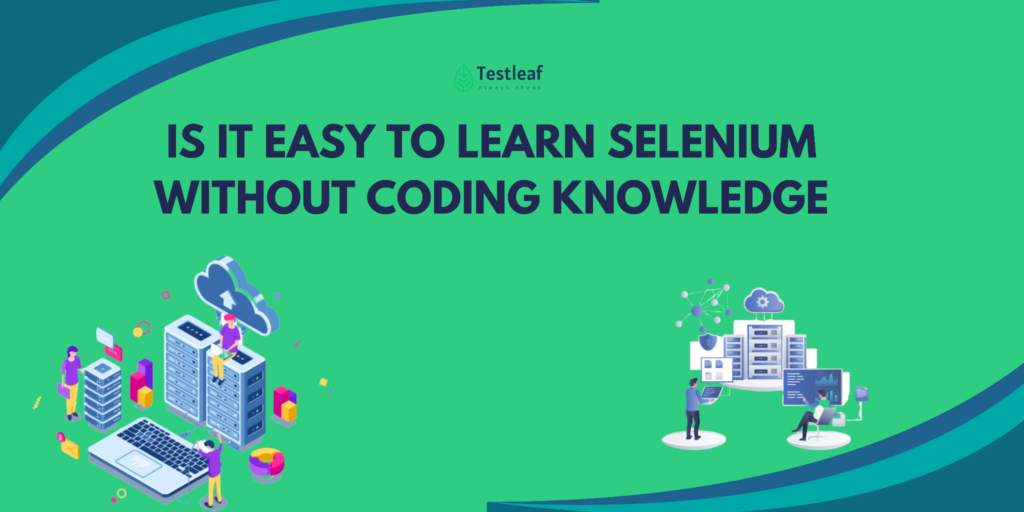If you’re preparing for a Cognizant (CTS) interview in 2026, this guide is for you! Whether you’re a manual tester transitioning to automation or an experienced QA engineer, knowing how to handle Java and Selenium-based interview questions can make all the difference.
CTS interviews are known for testing your core programming logic, automation approach, and real-time problem-solving skills. Based on Testleaf’s real interview experiences, we’ve compiled the Top 25 most commonly asked CTS Interview Questions and Answers — designed to help you crack your next interview confidently.
1. What are the different types of data types in Java?
Java supports two main categories of data types: Primitive and Non-Primitive. Primitive data types include byte, short, int, long, float, double, char, and boolean. Non-primitive data types include Strings, Arrays, Classes, and Interfaces. Primitive types are memory-efficient, while non-primitives are object-based and provide more flexibility.
💡 Expert Tip: CTS often asks follow-up questions about type casting — be ready to explain implicit vs explicit conversion.
2. Define an Array data type.
An Array is a collection of elements of the same data type stored in contiguous memory locations. It helps in storing multiple values under a single variable name, reducing redundancy. Arrays have a fixed size, meaning the number of elements cannot change once declared. They are useful for handling large datasets efficiently using indexes.
💡 Expert Tip: Prepare to explain Array vs ArrayList — a common CTS favorite.
Additional Resources: selenium interview questions
3. What are access modifiers and its types?
Access modifiers in Java define the visibility or scope of variables, methods, and classes. There are four types: public – accessible from anywhere, protected – accessible within the package and by subclasses, default – accessible only within the same package, and private – accessible only within the same class. They help in maintaining encapsulation and controlling data access.
💡 Expert Tip: Expect scenario-based questions like “When would you use protected over private?”
4. Explain static and non-static class members.
Static members belong to the class rather than any instance, meaning they can be accessed without object creation. They are used for shared resources like constants or utility methods. Non-static members belong to objects, requiring an instance for access. Static variables have a single memory allocation, while non-static ones have separate copies per object.
💡 Expert Tip: Be ready to explain memory usage or real examples like utility methods in Selenium.
5. What is a constructor and its types?
A constructor is a special method that initializes an object when it is created. It has the same name as the class and no return type. There are two types: Default Constructor (created automatically) and Parameterized Constructor (accepts arguments). Constructors help set initial values for object properties at the time of creation.
💡 Expert Tip: Mention how Selenium Page Object Model (POM) uses constructors for web element initialization.
6. What is inheritance and its types?
Inheritance allows one class to use the properties and methods of another, promoting code reusability. It forms an ‘is-a’ relationship between classes. Types of inheritance include Single, Multilevel, Hierarchical, and Hybrid. It enhances code maintainability and reduces redundancy in object-oriented programming.
💡 Expert Tip: Connect to Selenium — explain how WebDriver interface is extended by multiple driver classes.
7. What is the Object class in Java?
The Object class is the parent of all classes in Java, forming the root of the class hierarchy. Every class in Java either directly or indirectly inherits from the Object class. It provides key methods like toString(), equals(), hashCode(), and clone(). These methods enable basic object operations such as comparison, cloning, and conversion to string.
💡 Expert Tip: Know how equals() is used in comparing WebElement text in Selenium.
8. What is an exception and its types? How to handle it?
An exception is an event that disrupts the normal flow of a program during runtime. There are two main types: Checked exceptions (compile-time) and Unchecked exceptions (runtime). Java handles exceptions using try-catch-finally blocks or by declaring them with the throws keyword. Proper exception handling ensures smooth program execution and better fault tolerance.
💡 Expert Tip: CTS might ask for real-time scenarios like handling NoSuchElementException.
9. What is polymorphism and its types?
Polymorphism means ‘many forms,’ allowing a single method or object to behave differently based on context. It is of two types: Compile-time polymorphism (method overloading) and Runtime polymorphism (method overriding). This concept improves code flexibility and reusability. It is one of the core principles of Object-Oriented Programming.
💡 Expert Tip: Give examples using Selenium actions or Page Object overrides.
10. What is an abstract class and example in Java and Selenium?
An abstract class is a class that cannot be instantiated and can contain both abstract and concrete methods. It provides a partial implementation that subclasses can extend. Abstract classes are used when multiple subclasses share a common structure but have different implementations. They help achieve abstraction and reduce code duplication.
💡 Expert Tip: Relate it to framework design — like abstract BaseTest classes in Selenium projects.
Explore Similar Topics: automation testing interview questions
11. What is an interface and example in Java and Selenium?
An interface is a blueprint of a class that defines abstract methods without implementation. It helps achieve complete abstraction and multiple inheritance. A class implementing an interface must provide implementations for all its methods. Interfaces are widely used for defining standard behaviors across multiple classes.
💡 Expert Tip: Mention the WebDriver interface as an example.
12. Explain List and Set and their implementation classes.
A List is an ordered collection that allows duplicate elements, whereas a Set is unordered and doesn’t allow duplicates. Common implementations of List include ArrayList, LinkedList, and Vector. Set is implemented by HashSet, LinkedHashSet, and TreeSet. These collections simplify data storage, searching, and manipulation.
💡 Expert Tip: CTS often asks how to store unique locators or test data — Set is your answer.
13. What are the different types of locators in Selenium?
Locators are used to identify web elements in Selenium. The eight main types are ID, Name, ClassName, TagName, LinkText, PartialLinkText, XPath, and CSS Selector. Choosing the correct locator improves test accuracy and reduces flakiness. Among these, ID is considered the most reliable and fastest.
💡 Expert Tip: Always mention XPath as a backup and ID as the fastest.
14. Difference between findElement and findElements.
findElement() returns the first matching web element, throwing an exception if none are found. findElements() returns a list of all matching elements, returning an empty list if none exist. The former is used for single element interactions, while the latter is for multiple. Using the right method ensures efficient element handling during automation.
💡 Expert Tip: Mention how findElements() helps avoid flaky exceptions.
15. How to select a value from dropdown.
Dropdowns can be handled using a Select class that interacts with select tags. Values can be chosen by visible text, value, or index. This approach ensures flexibility when dealing with dynamic dropdowns. It’s commonly used in forms and UI validation testing.
💡 Expert Tip: Add a code snippet to impress interviewers:
Select dropdown = new Select(element);
dropdown.selectByVisibleText(“Option”);
16. How to switch to different frames.
Frames are used to divide a webpage into sections. To access elements inside a frame, Selenium must switch to it first. Switching can be done using the frame’s index, name/id, or WebElement. Proper frame handling ensures smooth interaction with complex web pages.
💡 Expert Tip: Combine with waits — frame switching often fails due to load delays.
17. What are the different types of waits in Selenium?
Waits handle synchronization between script execution and webpage response. There are three types: Implicit Wait, Explicit Wait, and Fluent Wait. They help prevent element not found errors by giving elements time to load. Choosing the right wait improves test stability and reliability.
💡 Expert Tip: CTS focuses on synchronization — be clear on when to use which.
You Should Also Read: api automation interview questions
18. How to handle multiple windows.
When multiple browser windows or tabs open, Selenium can switch between them using window handles. The driver stores unique IDs for each window and allows switching using those handles. This is essential when dealing with pop-ups, advertisements, or multi-step flows. Efficient window handling ensures complete test coverage for complex web apps.
💡 Expert Tip: Demonstrate closing popups dynamically in automation.
19. Usage of Jenkins and Maven.
Jenkins is a Continuous Integration tool that automates test execution and reporting. Maven is a build automation tool used for dependency management and project setup. Together, they streamline automation workflows and ensure continuous delivery. They are integral to modern DevOps-based testing pipelines.
💡 Expert Tip: Explain how Jenkins executes your Selenium tests automatically after each commit.
20. How to perform double click in Selenium.
A double-click action simulates rapid clicks on a web element. It is mainly used for UI actions like text selection or special triggers. This is performed using action classes that handle advanced mouse interactions. It’s crucial for automating real-user behaviors on web pages.
💡 Expert Tip: Mention other real-time actions like hover or drag-and-drop.
21. What is an assertion and its types?
Assertions validate actual results against expected outcomes during test execution. There are two types: Hard Assertions (stop execution on failure) and Soft Assertions (continue even after failure). They ensure test accuracy and reliability by verifying conditions. Assertions are widely used in testing frameworks like TestNG and JUnit.
💡 Expert Tip: Mention using SoftAssert for multiple validations.
22. Name any six exceptions you handle.
Common Selenium exceptions include: NoSuchElementException, TimeoutException, ElementNotVisibleException, StaleElementReferenceException, NoSuchFrameException, NullPointerException. Handling them ensures smooth and error-free automation execution.
💡 Expert Tip: Know how to handle StaleElementReferenceException — a common CTS question.
23. How to retrieve message from an alert box.
Alerts are small popup windows that display messages or confirmations. You can switch to the alert, read its message, and either accept or dismiss it. Handling alerts is essential for validating UI prompts and warnings. It ensures the script continues seamlessly without interruptions.
💡 Expert Tip: Include examples with accept/dismiss methods.
Related Posts: Epam Interview Questions
24. What are listeners in TestNG?
Listeners are special interfaces that monitor test execution and react to specific events. They can capture events like test start, success, failure, or skip. Common ones include ITestListener and ISuiteListener. They’re mainly used for logging, reporting, and custom test behavior.
💡 Expert Tip: Highlight how you used listeners for screenshots or logs.
25. Difference between setSpeed() and sleep() methods.
setSpeed() was used in older Selenium versions (RC) to slow execution; it is now deprecated. sleep() is a Java method that pauses execution for a defined duration. While setSpeed() affects all commands, sleep() pauses the entire thread. Using sleep() is common for fixed wait times during automation.
💡 Expert Tip: Explain why Thread.sleep() isn’t ideal for dynamic web apps.
Conclusion: Prepare Smart, Not Hard
Cracking a CTS (Cognizant) interview in 2026 requires more than memorizing theory — it’s about understanding real-world scenarios and thinking like an automation engineer.
At Testleaf, we’ve helped thousands of QA professionals master Java, Selenium, Playwright, and AI-driven testing through practical, hands-on learning.
📘 Ready to accelerate your QA career?
Join Testleaf’s Selenium Automation Course and gain hands-on experience with real CTS-style interview scenarios, expert guidance, and project-based learning from industry mentors.
Frequently Asked Questions (FAQs)
1. What skills are required to crack the CTS (Cognizant) automation interview in 2026?
To ace a CTS automation interview, focus on Java fundamentals, Selenium WebDriver, TestNG, and framework design patterns. Understanding CI/CD tools like Jenkins and version control systems like Git will also give you a competitive edge.
2. Is Selenium enough to get a job in Cognizant as a QA engineer?
Selenium is a great start, but CTS values professionals who understand the complete automation lifecycle — from writing robust test scripts to integrating them with Maven, Jenkins, and cloud execution tools. Pairing Selenium skills with AI-based testing knowledge makes you stand out.
3. How can a Selenium Automation Course help me prepare for Cognizant interviews?
A Selenium Automation Course provides hands-on training in real-world projects and interview-style challenges. Testleaf’s program includes CTS-style automation rounds, helping you master locators, waits, frameworks, and debugging techniques that recruiters expect in 2026.
4. What is the expected interview pattern for CTS automation testing roles?
Typically, there are three rounds — a technical coding test (Java/Selenium), a technical discussion covering frameworks and problem-solving, and an HR or managerial round to assess communication and scenario handling.
5. Which automation testing tools are important besides Selenium for CTS interviews?
In addition to Selenium, learning Playwright, Cypress, and API testing tools like Postman or RestAssured can boost your chances. These tools show your adaptability and readiness for modern automation environments.
6. How do I prepare for Selenium questions in Cognizant interviews?
Start by practicing common Selenium commands, writing dynamic XPath locators, and understanding test synchronization (waits). Revise framework concepts such as Page Object Model (POM) and Data-Driven Testing. Enrolling in a Selenium Automation Course helps solidify these skills through guided practice.
7. Does Cognizant focus on coding questions for QA automation roles?
Yes. Most CTS interviews for automation engineers include Java coding problems, often related to arrays, strings, collections, or loops. You may also need to write test scripts or debug existing code during technical rounds.
8. What salary range can Selenium automation testers expect at Cognizant in 2026?
For professionals with 2–5 years of experience, salaries range from ₹5.5 LPA to ₹12 LPA, depending on technical depth, framework design expertise, and exposure to DevOps or AI testing tools.
9. How can I move from manual testing to automation in Cognizant?
Start by learning core Java and then progress to Selenium WebDriver, TestNG, and Maven. Hands-on experience through a Selenium Automation Course helps bridge the gap by giving you real project experience to showcase during interviews.
10. Where can I get CTS-specific interview practice and expert mentoring?
You can join Testleaf’s Selenium Automation Course, where industry mentors conduct real Cognizant-style mock interviews, offer feedback on frameworks, and help you build confidence for actual interview scenarios.
We Also Provide Training In:
- Advanced Selenium Training
- Playwright Training
- Gen AI Training
- AWS Training
- REST API Training
- Full Stack Training
- Appium Training
- DevOps Training
- JMeter Performance Training
Author’s Bio:

As a Senior SDET with 8+ years in testing and development, I build scalable automation platforms ensuring quality at speed. Passionate about mentoring and innovation, I equip teams with real-time solutions and high-impact frameworks, driving excellence through continuous learning. Let’s shape the future of quality engineering together.
Dilipkumar Rajendran
Senior SDET | Playwright & Selenium Expert









